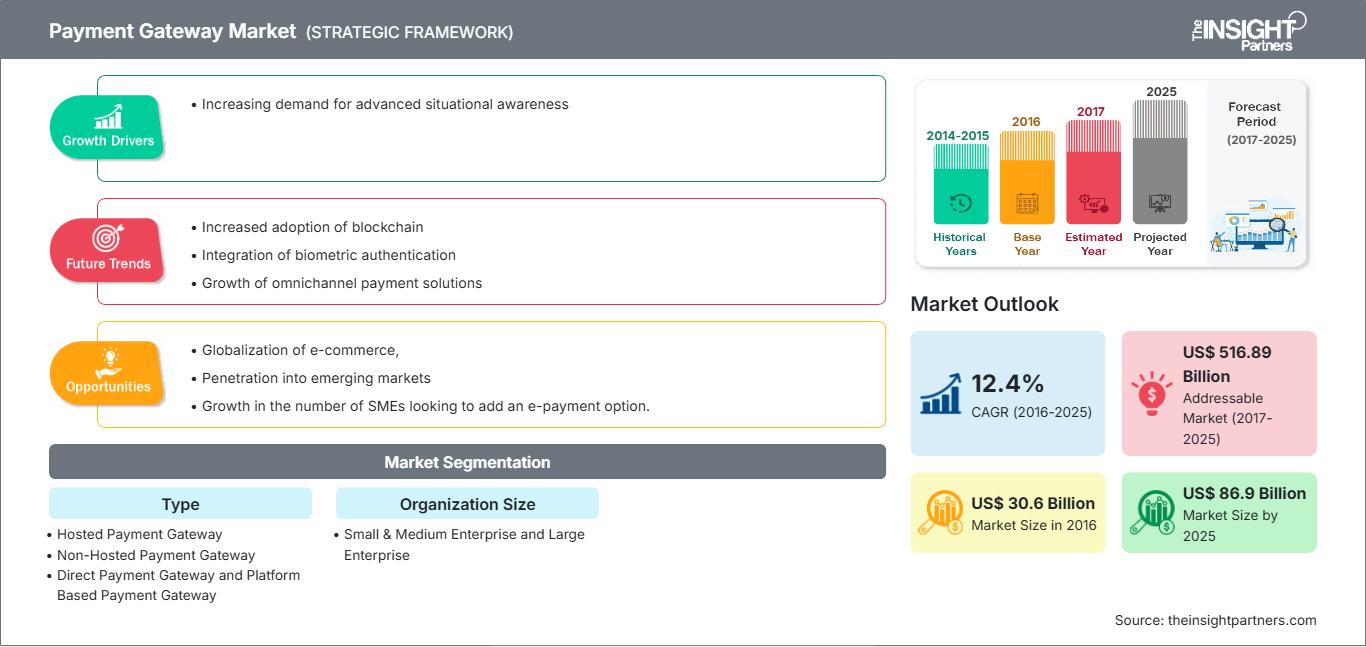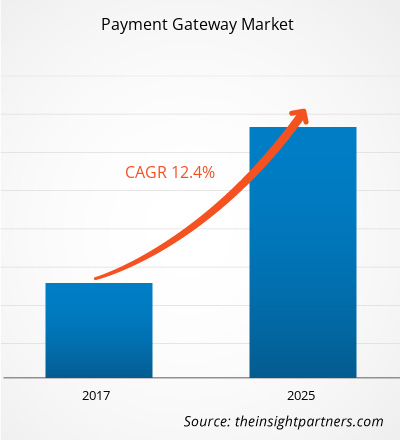Se espera que el mercado global de pasarelas de pago crezca de US$ 30,6 mil millones en 2016 a US$ 86,9 mil millones en 2025 a una CAGR del 12,4% entre 2017 y 2025.
Los comerciantes de todo el mundo están deseosos de expandir sus negocios transfronterizos mediante la adopción de un enfoque lógico, asociándose con pasarelas de pago. Con esta colaboración, estos comerciantes se benefician de las oportunidades que ofrece la globalización del comercio electrónico. La mayoría de los comerciantes actuales buscan la expansión global y desean crecer a un ritmo más rápido; sin embargo, lo último que necesitan en este panorama dinámico y competitivo es una pasarela de pago que frene su crecimiento o los obligue a colaborar con múltiples PSP (Proveedores de Servicios de Pago) en diferentes regiones. Para abordar estos problemas, la industria de pagos está impulsando avances tecnológicos, allanando el camino para el crecimiento del mercado de las pasarelas de pago.
Obtendrá personalización en cualquier informe, sin cargo, incluidas partes de este informe o análisis a nivel de país, paquete de datos de Excel, así como también grandes ofertas y descuentos para empresas emergentes y universidades.
Mercado de pasarelas de pago: perspectivas estratégicas

- Obtenga las principales tendencias clave del mercado de este informe.Esta muestra GRATUITA incluirá análisis de datos, desde tendencias del mercado hasta estimaciones y pronósticos.
El informe se centra en una segmentación exhaustiva de este mercado según el tipo de industria y el tamaño de la organización. La segmentación geográfica abarca seis regiones principales: Norteamérica, Europa, Asia-Pacífico (APAC), Oriente Medio y África (MEA) y Sudamérica (SA). El mercado regional se ha dividido aún más por países. Por segmento de tamaño de organización, las grandes empresas representaron la mayor cuota de mercado de pasarelas de pago en 2016; mientras que se espera que la región de Oriente Medio y África crezca a la mayor tasa de crecimiento anual compuesta (TCAC) durante el período de pronóstico. El informe busca ofrecer una visión general del mercado global de pasarelas de pago con una segmentación detallada. Además, analiza el panorama actual del mercado de pasarelas de pago y prevé su crecimiento hasta 2025. El informe abarca la dinámica del mercado durante el período de pronóstico. Asimismo, analiza el panorama competitivo, las tendencias geográficas y las oportunidades en los mercados con respecto a todas las regiones geográficas. El informe también incluye perfiles detallados de las empresas clave del mercado, junto con sus estrategias de mercado. El informe también proporciona un análisis PEST de las cinco regiones junto con el análisis FODA de todas las empresas perfiladas en el informe.
Perspectivas regionales del mercado de pasarelas de pago
Los analistas de The Insight Partners han explicado detalladamente las tendencias regionales y los factores que influyen en el mercado de pasarelas de pago durante el período de pronóstico. Esta sección también analiza los segmentos y la geografía del mercado de pasarelas de pago en Norteamérica, Europa, Asia Pacífico, Oriente Medio y África, y Sudamérica y Centroamérica.
Alcance del informe del mercado de pasarelas de pago
| Atributo del informe | Detalles |
|---|---|
| Tamaño del mercado en 2016 | 30.600 millones de dólares estadounidenses |
| Tamaño del mercado en 2025 | US$ 86.9 mil millones |
| CAGR global (2016-2025) | 12,4% |
| Datos históricos | 2014-2015 |
| Período de pronóstico | 2017-2025 |
| Segmentos cubiertos | Por tipo
|
| Regiones y países cubiertos | América del norte
|
| Líderes del mercado y perfiles de empresas clave |
|
Densidad de actores del mercado de pasarelas de pago: comprensión de su impacto en la dinámica empresarial
El mercado de las pasarelas de pago está creciendo rápidamente, impulsado por la creciente demanda de los usuarios finales debido a factores como la evolución de las preferencias de los consumidores, los avances tecnológicos y un mayor conocimiento de los beneficios del producto. A medida que aumenta la demanda, las empresas amplían su oferta, innovan para satisfacer las necesidades de los consumidores y aprovechan las tendencias emergentes, lo que impulsa aún más el crecimiento del mercado.

- Obtenga una descripción general de los principales actores clave del mercado de pasarelas de pago
Norteamérica es una de las regiones más destacadas en el mercado de pasarelas de pago, que aportará los mayores ingresos a nivel mundial gracias a los avances tecnológicos y a la considerable aplicación de pasarelas de pago en diferentes segmentos de usuarios finales. El rápido crecimiento de las economías de Asia-Pacífico (APAC), con un sector de la construcción en auge, allanará el camino para una mayor adopción e impulsará el mercado de las pasarelas de pago. Se espera que la región APAC lidere el mercado con la mayor tasa de crecimiento anual compuesta (TCAC) durante el período de pronóstico. Entre los actores clave del mercado de pasarelas de pago se incluyen PayPal Holdings, Inc., Amazon Payments, Inc., Secure Trading Limited, Cardstream Limited, CCBill, LLC, BitPay, Inc., GoCardless Ltd., Stripe Inc., Due Inc., Merchant Warrior, Authorize.Net y WePay Inc., entre otros.
- Análisis histórico (2 años), año base, pronóstico (7 años) con CAGR
- Análisis PEST y FODA
- Tamaño del mercado, valor/volumen: global, regional y nacional
- Industria y panorama competitivo
- Conjunto de datos de Excel
Informes recientes
Testimonios
Razón para comprar
- Toma de decisiones informada
- Comprensión de la dinámica del mercado
- Análisis competitivo
- Información sobre clientes
- Pronósticos del mercado
- Mitigación de riesgos
- Planificación estratégica
- Justificación de la inversión
- Identificación de mercados emergentes
- Mejora de las estrategias de marketing
- Impulso de la eficiencia operativa
- Alineación con las tendencias regulatorias




















 Obtenga una muestra gratuita para - Mercado de pasarelas de pago
Obtenga una muestra gratuita para - Mercado de pasarelas de pago